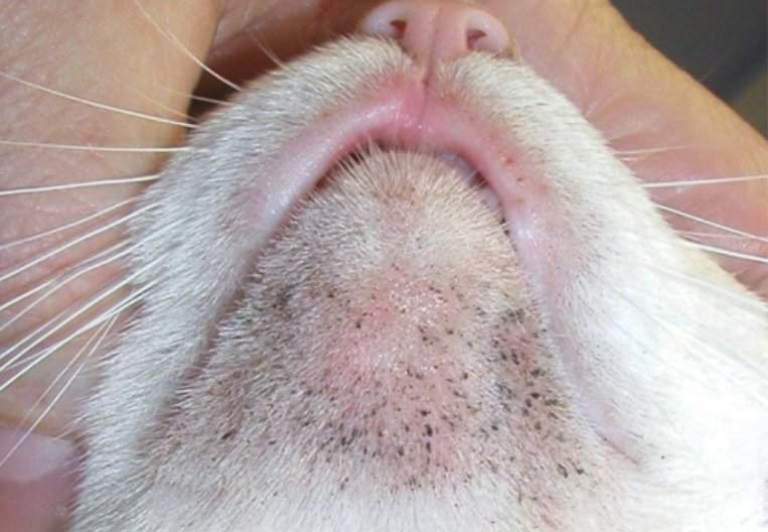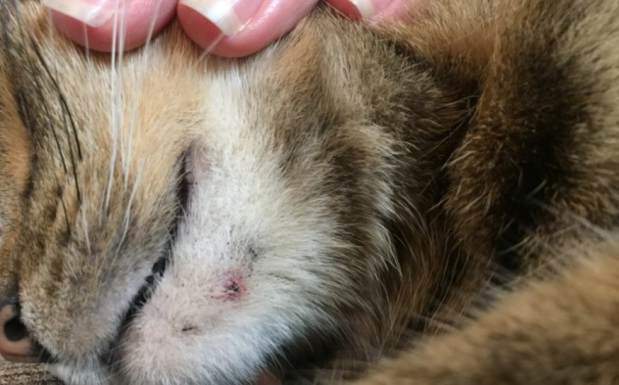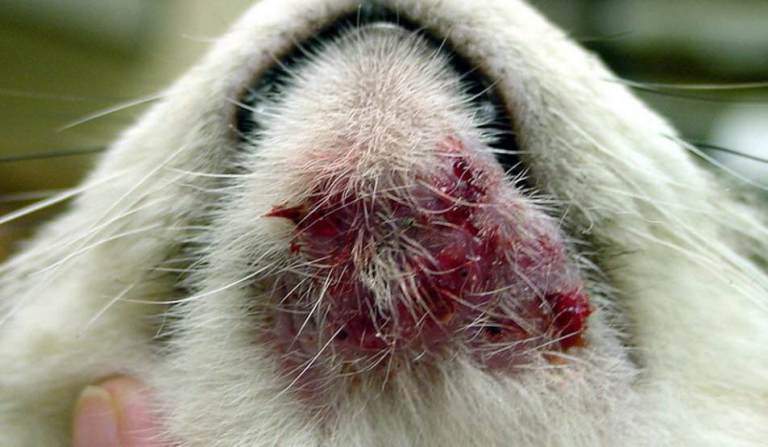What is cat acne?
Do cats get acne? Yes. They do. Just like in the case of acne in human beings, these pets also suffer from this skin condition which occurs when hair follicles get clogged (plugs or comedones are formed, especially blackheads).
The clogging is caused by sebum produced by the sebaceous glands in the chin area for lubrication and territory marking together with dead skin cells.
Typically, “feline acne usually looks like small, black, dirt-like spots on the underside of your cat’s chin or on the edge of the lips,” notes Purina.com
Once formed, these comedones may be harmless. However, they may result in not only irritation but also give way for secondary infections that will worsen things. Therefore, it is possible for cats to suffer from mild to a very severe form of acne characterized by alopecia, lesions, and crusts.
Whereas the chances of its occurrence are not related to sex, age or breed, as Wikipedia notes, “Persian cats are also likely to develop acne on the face and in the skin folds.” However, even a Sphynx cat which is hairless can also be affected. Usually, in white cats, it is much easily noticed.
Finally, feline acne can occur once, keep coming and going or be a long-life problem and other body areas especially skin folds can be affected besides the facial areas i.e., around their chin, lower lip, and upper lip areas, around their mouth or their nose.
What does cat acne look like – pictures
Its appearance will depend on if it is a mild or severe case and whether there has been any secondary infection or not.
Mild form
Mild forms will appear more like brownish or black stuff under cats chin (debris-like oily flecks) and plugged hair follicles. However, if you try brushing them off, they won’t come out. We have included the below two photos to help you know how they look like.
Mild cases do not cause much irritation or itchiness but may develop to severe, itchy bumps, pimples and nodules.


Severe feline acne
In case of a severe form, itchiness, irritation, and pain may arise and the initial small blackheads may become pustules.
In most instances, the severe form appears as red bumps and red lesions that may rupture and bleed if irritated, and afterward crusts (furunculosis).
There may be hair loss around the affected area as well as draining. Scratching will cause trauma, wounds and increase the chances of infections. The image

below should help you see how severe it can be.
Is feline acne contagious?
Cat acne is not contagious, i.e., it is not contagious to other felines, pets, or human beings just as in the case of human beings where it is not contagious. Therefore, cats cannot cause acne to us.
However, some of the resultant secondary skin infections especially if there is itching and irritation can be contagious, i.e., they can be transferrable.
What causes cat acne
From the way it is formed, you can conclude that it is due to clogged hair follicles in the affected areas. However, the exact reason as to why it occurs is not known.
Some of the factors that may influence its formation include:
- A hyperactive sebaceous gland produces a lot of sebum increasing the risk of hair follicles being clogged.
- Poor hygiene leading to the presence of bacteria. Using dirt watering dishes and feeding bowls may expose these pets to bacteria.
- Stress
- Hormonal imbalances are common at the ages of 2-4 years.
- Can cat allergies cause acne? Yes. They can. Contact dermatitis or allergic reactions to some of the toys you give them, medication, some foods, or the material of their feeding and drinking bowls especially plastic ones can be a cause.
- Chin rubbing on objects that are not clean or sanitized.
- Hair follicle problems
- Inadequate grooming especially to disabled and old cats that may not be able to effectively groom themselves or those that have long hair. Such require regular brushing and baths.
- A weakened immunity. It makes them vulnerable to some severe infections that can result in the eruption of acne.
Note
Yeast infection (such as Malassezia), skin mites, demodicosis, granuloma, ringworms, and other conditions may result in skin appearance that closely mimics acne. Therefore, proper diagnosis should be done to help distinguish such causes.
Diagnosis
Diagnosis is by physically looking at the various clinical signs presented, consider a cat’s medical history, conducting a microscopic examination and check for the presence of bacteria (using bacteria cultures).
Also, your vet may perform other tests to rule out other possible causes of similar pimple-like bumps such as fungal infection, mites, feline leprosy, tumors, among other conditions including urine and blood tests, biopsies (to check if the lesions are cancerous).
Feline acne treatment and home remedies?
How do you treat cat acne? The approach you take will depend on its severity. Mild cases may resolve on their own. However, severe cases including where there are pustules require the help of your veterinarian.
Even if you prefer home treatments using the various home or OTC products, it is good to let your vet confirm if the problem is acne or it could be other conditions, we have mentioned that some skin conditions may mimic it.
For mild cases, various home remedies for cat acne may be used which will include but not limited to:
- Topical benzoyl peroxide. Brands such as Davis Benzoyl Peroxide Medicated Dog & Cat Shampoo may be of much help.
- Warm compress
- Use of salicylic and antimicrobial shampoos and baths.
- Topical retinoid creams, gels, and ointment
- Witch hazel
- Apple cider vinegar
- Hydrogen peroxide
- betadine and Muricin
- chlorhexidine
- Brushing
- Cat acne wipes
- Aloe vera gel
- Manuka honey
- Zymox spray
- Cucumber pulp
- Neosporin
We have covered each of the above home remedies and mentioned a few more in our article on cat acne treatment at home.
Besides the home remedies, your veterinary may drain off any pustules present as well as prescribe injectable and oral systematic antibiotics often used for up to six weeks.
Additionally, he or she may prescribe other cat acne medicine including corticosteroid tablets or injection to help reduce inflammation. Also, severe cases may be managed by isotretinoin among other medications.
Remember, if left untreated, your fluffy friend may show some signs of pain such as yowling, being aggressive, meowing, and so on. Also, it can lead to folliculitis as well as secondary fungal infections.
Do not cat acne pop
Just like in the case of humans where dermatologists discourage the popping of pimples and acne, this is the same case for these pets as it will raise the possibilities of bacteria to spread leading to more outbreaks.
This advice is in line with what PETA notes, “you shouldn’t squeeze, pick at, or otherwise try to remove your cat’s pimples.”
Prevention
A complete cat acne cure may not be realistic. However, prevention may reduce incidences of breakouts and their severity.
To reduce and prevent breakouts, ensure your ceramic bowls that these pets use do not have small cracks as they may harbor bacteria. Also, avoid those made from plastic are porous and may harbor bacteria. Instead, use glass or metallic feeding and watering bowls.
Secondly, thoroughly and regularly be cleaning your feeding bowls with hot water to minimize the chances of them harboring any bacteria.
Finally, consider diet change where it is “ reducing grains, poultry, and seafood in your cat’s diet to see if the acne improves.”[1] Also, go for hydrolyzed cat diets and omega-3 supplements for cats.[2]
